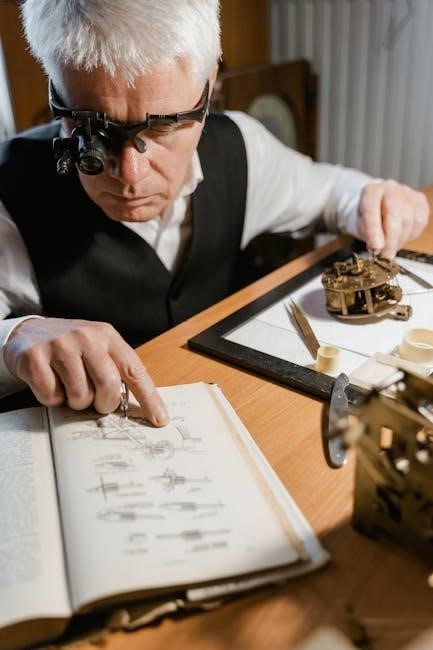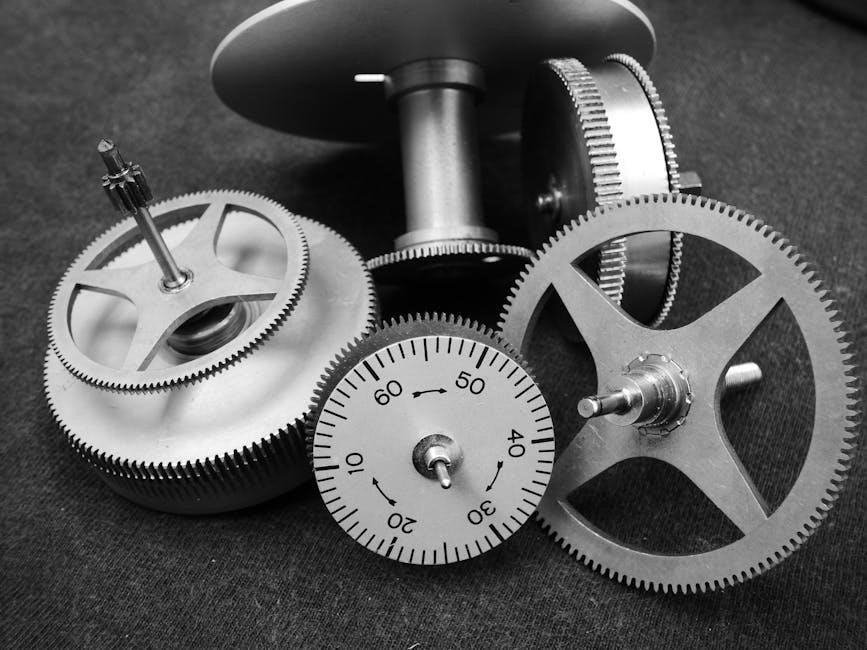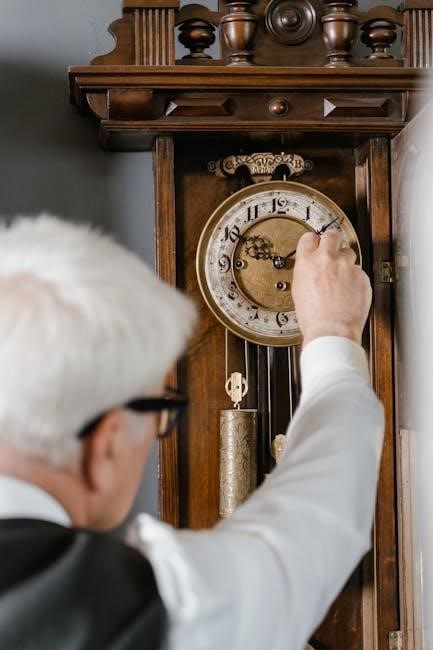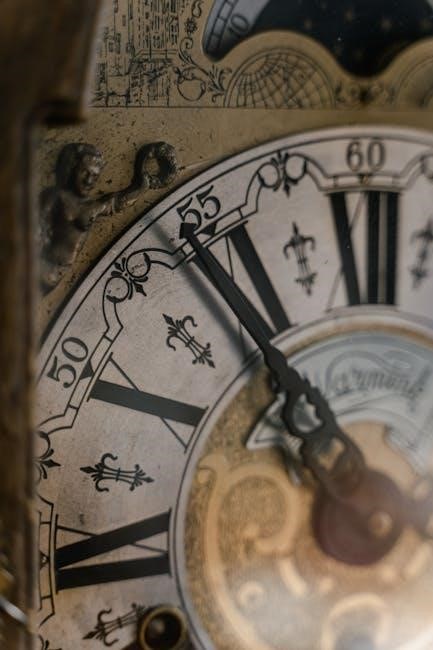Radio-controlled clocks use wireless signals from atomic clocks to synchronize time, ensuring high precision and automatic adjustments, eliminating manual settings.
What Are Radio-Controlled Clocks?

Radio-controlled clocks are timekeeping devices equipped with internal radio receivers tuned to signals from atomic clocks, such as the WWVB station in the U.S. These clocks automatically synchronize with the broadcasted time, ensuring high precision and eliminating manual adjustments. They receive updates regularly, adapting to time zones and daylight saving changes without user intervention, making them highly accurate and convenient for everyday use.
The Technology Behind Precision Timekeeping
Radio-controlled clocks rely on long-wave signals from atomic clocks, such as WWVB in the U;S., broadcasting precise time data. These signals are decoded by the clock’s receiver, synchronizing its internal timekeeping. The technology ensures accuracy to within a second over millions of years, with automatic adjustments for daylight saving time and time zones, eliminating the need for manual corrections and providing reliable, maintenance-free operation.

Installation and Setup
Insert a fresh battery, and the clock automatically scans for the WWVB signal, setting the time and zone. The hands move to 12 o’clock initially.
Optimal Placement for Signal Reception
Place the clock near a window, ideally facing the direction of the nearest atomic clock transmitter. Avoid areas near electronics, microwaves, or computers, as they may interfere with the signal. Keep the clock at least 5 feet away from televisions, radios, and other wireless devices to ensure uninterrupted reception. Positioning the clock in a central location with minimal obstructions enhances signal strength for accurate time synchronization.
Step-by-Step Initial Setup
Begin by inserting a fresh AA battery, ensuring the clock powers on. The second hand will reset to the 12 o’clock position. Place the clock in an optimal location for signal reception; Allow it to synchronize with the WWVB signal, which may take a few minutes. Once synchronized, the clock will automatically update the time and date. For manual adjustments, press the time zone button to cycle through available zones until the correct one is displayed. This completes the initial setup.

Time Zone Configuration
Radio-controlled clocks automatically detect time zones or allow manual selection. Press the time zone button to cycle through options and confirm your region for accurate timekeeping.
Understanding Supported Time Zones

Radio-controlled clocks support multiple time zones, typically covering regions like Pacific, Mountain, Central, and Eastern Time in the US. Some models may also include international zones. The clock automatically synchronizes with the selected zone, ensuring accurate time display. Users can manually adjust the time zone setting to match their location, with options often accessed via a dedicated button or menu. This feature ensures the clock remains precise regardless of geographical location.
Manually Selecting Your Time Zone
To manually select your time zone, press and hold the time zone button until the zone indicator flashes. Use the forward or backward buttons to cycle through available zones (e.g., Pacific, Mountain, Central, Eastern). Once your desired zone is displayed, release the button to confirm. This feature is useful when the clock cannot automatically synchronize or when traveling across time zones, ensuring accurate timekeeping without relying on signal reception.
Signal Reception and Synchronization
Radio-controlled clocks receive precision time signals from atomic clocks, ensuring accurate synchronization. The clock automatically tunes into signals like WWVB, adjusting to the correct time seamlessly and reliably;
How the Clock Receives the WWVB Signal
The clock is equipped with a built-in radio receiver tuned to the WWVB signal, transmitted by the National Institute of Standards and Technology (NIST) in Fort Collins, Colorado. This low-frequency signal broadcasts the exact atomic clock time, allowing the clock to synchronize automatically. The clock typically searches for the signal at night when interference is minimal. Once received, it adjusts its time display to match the atomic clock’s precision, ensuring accurate timekeeping without manual intervention. The process is seamless and occurs periodically to maintain synchronization.
Troubleshooting Signal Reception Issues
If the clock fails to receive the WWVB signal, ensure it is placed away from electronics like TVs, radios, and computers, which can cause interference. Avoid metal structures or concrete walls that may block the signal. Use a fresh alkaline battery to ensure proper function. Move the clock to a higher location or near a window for better reception. If issues persist, check the time zone setting or wait for nighttime, as signals are typically stronger then.
Daylight Saving Time (DST) Adjustments
Radio-controlled clocks automatically update for DST, syncing with atomic clocks for accurate time changes, eliminating the need for manual adjustments during time transitions.
Automatic DST Updates
Radio-controlled clocks automatically adjust for daylight saving time (DST) by receiving signals from atomic clocks, ensuring seamless transitions without manual intervention. These clocks synchronize with signals like those from NIST’s WWVB station, accurately switching between standard and daylight saving time. This feature eliminates the need for manual time changes, reducing errors and ensuring precise timekeeping year-round. The clock automatically detects DST start and end dates, updating instantly for accurate time display.

Manual Override for DST
For regions without automatic DST or to bypass the feature, manual override is available. Disable the auto-DST setting via the clock’s menu, then adjust the time zone or hour manually. Ensure the correct time zone is selected and verify the time accuracy post-adjustment. This option is useful in areas where DST rules differ or when signal reception is unreliable, allowing precise control over time settings. Always refer to the user manual for specific button sequences and instructions.

Additional Features and Customization
Beyond timekeeping, many radio-controlled clocks offer alarms, thermometers, and customizable displays, enhancing functionality and user convenience while maintaining precise synchronization with atomic time signals.
Beyond Timekeeping: Alarms and Thermometers

Radio-controlled clocks often feature alarms and thermometers, enhancing their functionality beyond precise timekeeping. Alarms can be set to specific times with optional snooze functions, ensuring you never miss an appointment. Thermometers provide accurate temperature readings, often switchable between Celsius and Fahrenheit. These features make radio-controlled clocks versatile additions to any home or office, combining practicality with technological precision;
Setting Up Additional Features
Setting up additional features on your radio-controlled clock is straightforward. For alarms, press the alarm button to cycle through settings, choosing between multiple alarms or snooze functions. Thermometers typically require no setup, displaying temperature automatically. Some clocks allow toggling between Celsius and Fahrenheit. Refer to the manual for specific button sequences to activate and customize these features, ensuring your clock meets your needs beyond timekeeping.
Troubleshooting Common Issues
Troubleshooting common issues with radio-controlled clocks often involves checking signal reception, ensuring proper placement, and verifying time zone settings. Resetting the clock may resolve synchronization errors.
Resolving Synchronization Problems
If your radio-controlled clock fails to synchronize, ensure it is placed away from interfering devices like TVs, radios, and computers. Reset the clock by removing the battery, waiting 10 seconds, and reinstalling it. Verify that the correct time zone is selected. If issues persist, check for nearby metal objects or electrical interference. Move the clock to a location with better signal reception. If manual override is needed, refer to the instructions for adjusting the time zone or signal reception settings.
Addressing Interference and Lost Signal
Interference from electronic devices like TVs, microwaves, and computers can disrupt signal reception. Relocate the clock away from such devices and ensure it is not near metal objects, which can block the signal. If the signal is lost, move the clock to a central location or higher elevation. Check for nearby sources of electromagnetic interference and remove obstacles. Resetting the clock by removing the battery for 10 seconds may also restore signal reception.

Maintenance and Care
Regularly clean the clock with a soft cloth and avoid exposure to extreme temperatures or humidity. Replace batteries as needed to ensure optimal performance and signal reception.
Battery Replacement and Care Tips
Replace the battery with a fresh alkaline AA or AAA, ensuring correct terminal alignment. Open the compartment, typically on the back or bottom, possibly requiring a screwdriver. Avoid mixing old and new batteries. After replacement, the clock should automatically seek the radio signal. For optimal performance, clean with a soft cloth, avoiding harsh chemicals. Store in a stable environment, away from extreme temperatures and humidity. Remove the battery during storage to prevent leakage and wrap it protectively. Consult the manual for specific care instructions and troubleshooting.
Cleaning and Storage Guidelines
Clean your radio-controlled clock with a soft, dry cloth, gently wiping away dust and dirt. Avoid using harsh chemicals or abrasive materials. For storage, place the clock in a cool, dry environment, away from direct sunlight. Remove the battery to prevent leakage and store it separately, wrapping it in protective material. Ensure the clock is securely packaged to avoid damage during transport. Follow these guidelines to maintain optimal performance and longevity.